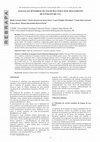Papers by Renata Hernandez Barros Fuchs

Direitos para esta edição cedidos à Atena Editora pelos autores. Open access publication by Atena... more Direitos para esta edição cedidos à Atena Editora pelos autores. Open access publication by Atena Editora Todo o conteúdo deste livro está licenciado sob uma Licença de Atribuição Creative Commons. Atribuição-Não-Comercial-NãoDerivativos 4.0 Internacional (CC BY-NC-ND 4.0). O conteúdo dos artigos e seus dados em sua forma, correção e confiabilidade são de responsabilidade exclusiva dos autores, inclusive não representam necessariamente a posição oficial da Atena Editora. Permitido o download da obra e o compartilhamento desde que sejam atribuídos créditos aos autores, mas sem a possibilidade de alterá-la de nenhuma forma ou utilizá-la para fins comerciais. Todos os manuscritos foram previamente submetidos à avaliação cega pelos pares, membros do Conselho Editorial desta Editora, tendo sido aprovados para a publicação com base em critérios de neutralidade e imparcialidade acadêmica. A Atena Editora é comprometida em garantir a integridade editorial em todas as etapas do processo de publicação, evitando plágio, dados ou resultados fraudulentos e impedindo que interesses financeiros comprometam os padrões éticos da publicação. Situações suspeitas de má conduta científica serão investigadas sob o mais alto padrão de rigor acadêmico e ético.
(CIP) (eDOC BRASIL, Belo Horizonte/MG) P964 A produção do conhecimento nas ciências da saúde 2 [r... more (CIP) (eDOC BRASIL, Belo Horizonte/MG) P964 A produção do conhecimento nas ciências da saúde 2 [recurso eletrônico] / Organizador Benedito Rodrigues da Silva Neto.-Ponta Grossa (PR): Atena Editora, 2019.-(A Produção do Conhecimento nas Ciências da Saúde; v. 2) Formato: PDF 1. Abordagem interdisciplinar do conhecimento. 2. Saúde-Pesquisa-Brasil. I. Silva Neto, Benedito Rodrigues da. II. Série. CDD 610.7 Elaborado por Maurício Amormino Júnior-CRB6/2422 O conteúdo dos artigos e seus dados em sua forma, correção e confiabilidade são de responsabilidade exclusiva dos autores. 2019 Permitido o download da obra e o compartilhamento desde que sejam atribuídos créditos aos autores, mas sem a possibilidade de alterá-la de nenhuma forma ou utilizá-la para fins comerciais.

International Journal of Food Science and Technology, Apr 13, 2022
This paper describes the sensory profile of gluten‐free bread prepared with teff, sorghum and yac... more This paper describes the sensory profile of gluten‐free bread prepared with teff, sorghum and yacon flours, using Check‐All‐That‐Apply (CATA) and Just‐About‐Right (JAR) methods. The sorghum flour bread was characterised by porosity, reddish colour, bread and yeast aroma, crust hardness, floury and sour aroma, and unpleasant consistency. The teff flour bread was characterised by floury flavour, salty taste, grittiness and cereal aroma. The flavour attributes of both products were judged as ideal. The yacon flour bread was characterised as sweet aroma, softness, rubbery, unpleasant taste, chewiness, moistness, adhesiveness and bitterness. The attribute sweet taste was considered beyond the ideal and salty taste below the ideal. The flour‐mixed formulation was characterised by a pleasant aroma, chewiness and springiness. The attributes salty taste, sweet taste and softness were considered ideal. The mixture of these flours contributes to obtaining gluten‐free bread with better sensory characteristics than when using these flours alone.

Brazilian Journal of Biology, 2024
Tilapia has high-temperature tolerance, can breed in captivity, grow fast, and have excellent cos... more Tilapia has high-temperature tolerance, can breed in captivity, grow fast, and have excellent cost-benefit. Because of these characteristics, this species is of great interest in aquaculture and, currently, the most produced fish in Brazil. However, by increasing tilapia production, there was also a rise in the amount of organic waste, mainly from filleting, which discards 70% of waste. There are many studies on collagen extraction from tilapia skin as an alternative to reduce these residues and add commercial value. In this work, the extraction of protein concentrate was tested using an acid protocol, in which the tilapia skins underwent a pre-treatment in an acid medium and saline precipitation, with variations in time and concentration. After its extraction, the skin was evaluated for ash, moisture, protein, solubility, and pH. The protein concentrate obtained showed low ash contents, and the humidity is within those presented by the literature. The protein concentrate showed levels from 68.73 to 80.58% of protein and a low solubility between 4.03 to 6.93%. In conclusion, acid extraction is a possible means of collagen extraction, and tilapia skin is a good alternative to reuse waste generated in the fish industry.
Social Science Research Network, 2023

International Journal of Food Science and Technology, Mar 27, 2023
SummaryReplacing gluten‐containing flours with gluten‐free ingredients is a challenge for the foo... more SummaryReplacing gluten‐containing flours with gluten‐free ingredients is a challenge for the food industry due to the technological properties of this protein. This work aimed to evaluate, through the acceptance test, Flash Profile, and Just About Right (JAR), gluten‐free bread formulations made with sorghum, teff, and yacon flours. Through experimental design, nine formulations were submitted to acceptance test, which provided the formulation optimised by the overall acceptance scores of the samples. In the subsequent trials, four formulations were evaluated, F1 (100% sorghum), F2 (100% teff), F3 (100% yacon), and F4 (optimised formulation, with 33.33% of each flour). F1 was described by bread yeast odour, crumb texture, and salty taste. F2 presented a salty taste and bread flavour. F3 was characterised by softness, crumb texture, moisture, chewiness, and porosity. F4 was described by pleasant aroma, yeast odour, sweet taste, crumb texture, and porosity, and being the best evaluated in terms of overall acceptance. The descriptive sensory profile of the formulations highlighted attributes that enabled the use of sorghum, teff, and yacon in the preparation of gluten‐free bread and highlighted that the mixture of the three in the optimised formulation positively influences the sensory characteristics of the product, improving flavour, taste, and texture.

International Journal of Food Science & Technology
SummaryThis study evaluated the influence of replacing sugar with Stevia rebaudiana leaves on glu... more SummaryThis study evaluated the influence of replacing sugar with Stevia rebaudiana leaves on gluten‐ and lactose‐free cakes' sensory and physicochemical characteristics. The cakes underwent microbiological analysis, texture profile, specific volume, acceptance test and purchase intention, as well as the rate‐all‐that‐apply (RATA) descriptive test. With the results of the acceptance test and texture profile, the desirability function was applied in order to obtain an optimised formulation (FO) with lower values for hardness and chewiness and higher values for overall acceptance. As the stevia content in the cakes increased, the acceptability of these attributes decreased, and the same occurred with purchase intention. In the texture profile, only hardness, chewiness, gumminess and specific volume showed significant differences, influenced by the sugar content, since this component adds positively to the dough and texture of the cakes. Applying the desirability function, the opti...

International Journal of Food Science & Technology
SummaryReplacing gluten‐containing flours with gluten‐free ingredients is a challenge for the foo... more SummaryReplacing gluten‐containing flours with gluten‐free ingredients is a challenge for the food industry due to the technological properties of this protein. This work aimed to evaluate, through the acceptance test, Flash Profile, and Just About Right (JAR), gluten‐free bread formulations made with sorghum, teff, and yacon flours. Through experimental design, nine formulations were submitted to acceptance test, which provided the formulation optimised by the overall acceptance scores of the samples. In the subsequent trials, four formulations were evaluated, F1 (100% sorghum), F2 (100% teff), F3 (100% yacon), and F4 (optimised formulation, with 33.33% of each flour). F1 was described by bread yeast odour, crumb texture, and salty taste. F2 presented a salty taste and bread flavour. F3 was characterised by softness, crumb texture, moisture, chewiness, and porosity. F4 was described by pleasant aroma, yeast odour, sweet taste, crumb texture, and porosity, and being the best evaluat...
Journal of Food Processing and Preservation
Journal of Food Processing and Preservation
UNIVERSIDADE CESUMAR, Oct 27, 2009

Revista Brasileira de Pesquisa em Alimentos, 2010
O presente trabalho teve por objetivo avaliar sensorialmente as salsichas com e sem tratamento co... more O presente trabalho teve por objetivo avaliar sensorialmente as salsichas com e sem tratamento com extrato de uva. Foi realizado teste de aceitação com escala hedônica estruturada de 9 pontos, para os atributos de sabor, aparência, aroma e impressão global. A avaliação sensorial da salsicha em relação a sabor e aroma não obteve diferença significativa para os dois atributos, com valor igual a 7,72 aproximando-se da categoria gostei muito. Em relação à aparência e impressão global observou-se diferença significativa com e sem tratamento com extrato de uva, 7,8; 4,7e 7,56; 6,16. Esses resultados de aceitação nos permitem admitir que a coloração escura conferida pelo banho com extrato de uva tornou a salsicha menos aceita. Como a aparência é um dos atributos mais importantes na aceitação global influencia também sua aceitabilidade. Salsicha. Extrato de uva. Teste de aceitação. Cárneo.

International Journal of Food Science & Technology
SummaryThis study aimed to optimise an orange flavour gluten‐free cake formulation using rice flo... more SummaryThis study aimed to optimise an orange flavour gluten‐free cake formulation using rice flour, teff, sorghum and yacon. Nine cake formulations were initially submitted for acceptance and purchase intent tests with 66 assessors, where colour, odour, flavour, texture and overall acceptance were judged. After the result of the acceptance test and purchase intention, an optimised formulation (OP) was elaborated through the desirability function. This formulation was composed of 25% rice flour, 60% sorghum flour and 15% teff flour. After that, the sensory test of the Flash Profile was carried out to evaluate the consensus of the assessors about the optimised formulation, and for the 33 assessors of the Flash Profile test, with the method of analysis by Common Dimensions (ComDim), 92.29% described the F3 formulations (100% teff) and FO (optimised) are similar. This can be explained by the fact that the formulations have teff flour in their composition, while formulations F1 and F2 a...

Semina: Ciências Agrárias, 2012
Este trabalho teve como objetivos a obtenção de concentrado protéico de peixe a partir da carne m... more Este trabalho teve como objetivos a obtenção de concentrado protéico de peixe a partir da carne mecanicamente separada de tilápia do Nilo através de uma metodologia modificada, bem como realizar caracterização físico-química, microbiológica e sensorial do produto obtido. O concentrado protéico foi obtido a partir da carne mecanicamente separada de tilápia do Nilo, através da modificação de uma metodologia já existente, com alterações nas etapas de desodorização e deslipidificação. A caracterização físico-química da matéria-prima e do produto obtido consistiu das seguintes análises: umidade, lipídios, proteínas, cinzas, atividade de água e o grau de oxidação lipídica. As análises microbiológicas consistiram na determinação de Staphylococcus aureus, Coliformes a 45 °C e Salmonella sp. Utilizou-se o teste de Escala Hedônica para avaliar a aceitação dos atributos sensoriais de aspecto geral, cor e aroma. A carne mecanicamente separada e o concentrado protéico de peixe obtiveram, respectivamente, os seguintes percentuais com relação à umidade (77,24 e 4,85%), proteína (17,48 e 85,16%), lipídios (4,46 e 8,20%) e cinzas (1,02 e 2,45%). Os atributos aspecto geral e cor obtiveram os seguintes percentuais, respectivamente, 46,67 e 60,0%, na faixa de aceitação da escala. O aroma obteve grande rejeição, alcançando uma frequência de 70,0%. A modificação realizada na metodologia de processamento do concentrando protéico de pescado permitiu a obtenção de um produto com baixo teor de lipídios, além de reduzida umidade e elevado teor protéico, de qualidade microbiológica adequada permitindo a obtenção de um produto que poderá ser utilizado para o enriquecimento protéico de alimentos diversos.










Uploads
Papers by Renata Hernandez Barros Fuchs